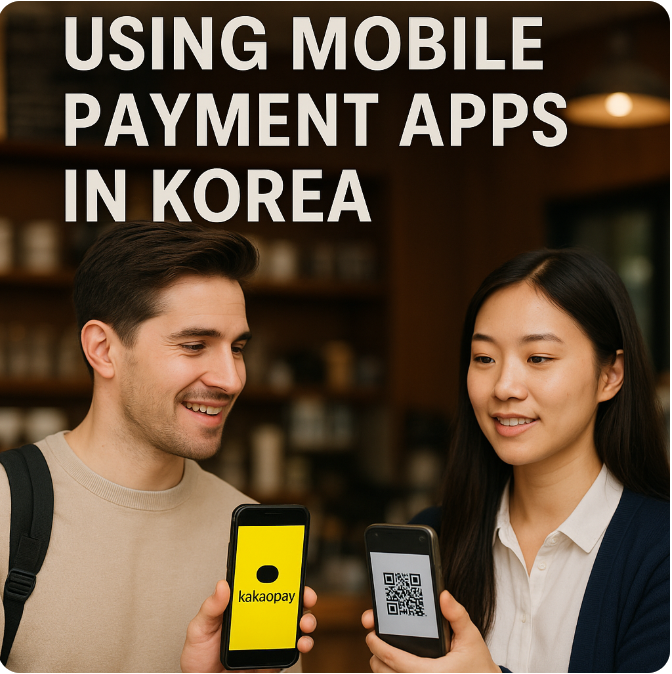How to Use Mobile Payment Apps in Korea – A Complete Guide for Foreigners
※ This article is based on official information as of August 21, 2025.
Summary at a Glance
South Korea is one of the most digitally advanced countries in the world, and nowhere is this more visible than in its mobile payment apps in Korea. From buying coffee at a convenience store to paying subway fares or splitting the dinner bill, Koreans rely on mobile payment platforms like KakaoPay, Naver Pay, Toss, Samsung Pay, and Payco every single day. For foreigners, understanding how these apps work is not just a convenience—it’s essential for navigating daily life.
Unlike in some countries where credit or debit cards still dominate, Korea has embraced cashless and contactless payments faster than almost anywhere else. Many cafés, taxis, and even small street vendors now prefer mobile payments. However, foreigners face unique hurdles: you typically need a Korean phone number, a local bank account, and an Alien Registration Card (ARC) to unlock full features.
This guide explains eligibility, step-by-step setup, regional differences, real-life case studies, cultural tips, and FAQs. By the end, you’ll not only understand the best mobile payment apps in Korea but also know exactly how to register and start using them—whether you’re a tourist, student, or long-term expat.
Eligibility & Conditions
To use mobile payment apps in Korea, foreigners must meet several requirements.
- Alien Registration Card (ARC)
Essential for full verification. Without this, most apps only allow limited features. - Korean Phone Number
Must be under your name. Prepaid SIMs usually don’t work; you need a registered mobile plan. - Local Bank Account
Banks like Shinhan, KB Kookmin, Woori, or Hana are the most foreigner-friendly. - Smartphone Compatibility
- Android: Works with all apps.
- iOS: Some features may be limited, especially NFC-based Samsung Pay.
- Tourists vs. Long-Term Residents
- Short-term visitors: Samsung Pay is the easiest with an international credit card.
- Residents: With ARC + local bank account, you can use KakaoPay, Toss, Naver Pay, and Payco fully.
Step-by-Step Application Guide
1. KakaoPay
- Integrated inside KakaoTalk.
- Steps: Download KakaoTalk → Verify phone + ARC → Link bank account → Start QR payments and transfers.
- Best for: Bill splitting, convenience stores, taxis.
2. Naver Pay
- Mainly for online shopping and food delivery.
- Steps: Create Naver account → Verify ARC → Link card or account → Pay on Coupang, Baemin, etc.
- Best for: Online shopping discounts.
3. Toss
- A fintech “super app.”
- Steps: Download Toss → Verify ARC + bank → Use for instant transfers.
- Best for: Splitting bills, financial services (insurance, loans, investments).
4. Samsung Pay
- NFC tap-to-pay.
- Steps: Register card → Verify → Pay with your phone at terminals.
- Best for: Tourists and travelers without ARC.
5. Payco
- Popular for loyalty programs.
- Steps: Download Payco → Verify ARC → Link bank or card.
- Best for: Discounts at partnered shops, movie theaters, cafés.
💡 Tip: Always keep your ARC and mobile banking app ready when registering. Extra verification for foreigners is common.
Regional Differences (Seoul vs Other Regions)
- Seoul/Capital Region: QR codes everywhere. KakaoPay & Toss dominate.
- Smaller Cities: Some shops prefer cash. Samsung Pay tap-to-pay more reliable.
- Tourist Hotspots (Busan, Jeju, Incheon): Wide acceptance, but Samsung Pay often easiest for tourists.
Real-Life Case Examples
- Maria (Spain, exchange student): Couldn’t use KakaoPay until ARC arrived. Then used Toss for rent + dinners.
- James (USA, business traveler): Only two weeks in Korea. Relied on Samsung Pay with US Visa card.
- Ayesha (Pakistan, teacher): Paid rent instantly via Toss—cheaper than bank transfers.
- Tomoko (Japan, tourist): At first used cash, later Samsung Pay at convenience stores.
- Carlos (Mexico, software engineer): Uses Naver Pay for groceries, KakaoPay for taxis, Toss for team dinners.
- Sophie (France, freelancer): Saved ₩100,000/year using Payco discounts.
- Ahmed (Egypt, grad student): Needed Korean friend’s help to register Toss; later used for tuition.
FAQ (15 Questions)
- Can tourists use KakaoPay? → No, ARC required.
- Is Samsung Pay available for foreigners? → Yes, with international card.
- Do I need a Korean phone number? → Yes, for most apps.
- Which app is most universal? → KakaoPay.
- Can I pay subway fares? → Yes, via KakaoPay/Samsung Pay.
- Do these apps support English? → Very limited.
- Can I send money abroad? → Toss Global offers remittances.
- What if I lose my phone? → Re-verification required; notify bank immediately.
- Fees? → Domestic transfers usually free.
- Best for discounts? → Naver Pay & Payco.
- Can I withdraw cash? → KakaoPay/Toss allow ATM withdrawals.
- Apple Pay? → Yes (since 2023), less popular.
- Do taxis accept? → Yes, in big cities.
- Under-19s? → Limited use only.
- Safe? → Yes, with OTP + biometrics.
Cultural Tips + Common Mistakes
- In group dinners, locals expect KakaoPay transfers.
- Some cafés are cashless now.
- Don’t ignore loyalty points—you’ll miss out on real savings.
Insurance & Airlines + Psychological Support
- Airlines like Jeju Air and T’way offer discounts via Naver Pay or KakaoPay.
- Travel insurance can now be paid with KakaoPay.
- Using mobile apps reduces financial stress for new expats.
One Thing Worth Sharing
If you stay longer than three months, get your ARC and open a bank account immediately. This unlocks all apps and makes life smoother.
A Last Line to Keep in Mind
Mastering mobile payment apps in Korea is not just about convenience—it’s about belonging. Once you can pay like locals, you’ll feel truly at home.
✅ Official Links
📌 Source: Ministry of Science and ICT (Updated 2025.08)
